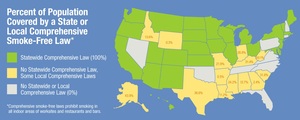One evening in October, my wife and I arrived for a brief get away on the Mississippi Gulf Coast. It was nearing 10 PM, and all the restaurants were closing for the evening. Very hungry and not wanting to drive into town for fast food, we were directed to a local bar that served pizza at all hours. We ordered at the bar and awaited our meal when, much to my surprise, a woman sat down beside me and exhaled a thick haze of noxious tobacco smoke all around us. It has been many years since I have had to endure the annoyance (and injury) from secondhand smoke exposure. Fortunately, the woman moved on, and our pizza arrived before we made a speedy exit from this non-smoke-free environment. We were able to leave, but the employees had to continue breathing the airborne toxins as a condition of employment. Although many communities in Mississippi have adopted smoke-free air ordinances, this is not universal, and Mississippi has no state prohibition.
Tobacco abuse is the leading cause of preventable death in the United States, with around 1 in 5 deaths attributable to this product.1,2 Approximately 41,000 of these deaths are due to secondhand smoke.1 As recently shared through the Mississippi State Department of Health’s Public Health Report Card, Mississippi has the 4th highest rate of smoking in the U.S., and each year, over 5,000 Mississippians die because of their tobacco addiction. Another 500 die from secondhand smoke exposure.3 Thirty-three percent of all cancer deaths in our state are attributable to tobacco addiction.1 Despite these alarming statistics, Mississippi has embraced few of the evidence-based policies proven to combat tobacco-related death and morbidity.
The American Lung Association assesses each state for various proven tobacco policies. Our state receives an F in prevention funding, smoke-free air, tobacco taxation policy, and flavored products while receiving a D in access to cessation services.4 In recent legislative sessions, we have not seen substantial efforts to implement the proven tobacco control strategies that garnered much interest in previous years, such as increasing tobacco taxes. Mississippi currently ranks 40th in the tobacco tax rate. An analysis from the American Cancer Society in 2021 demonstrated that an increase to $1.50 per pack (from the current $0.68) would cut youth smoking by 14.5%, help 19,300 kick their addiction, and save another 7,400 from premature death.5 This would also reduce long-term health costs in our state by over half a billion dollars.
In this issue of the Journal, Katerina Sergi et al., in Tobacco Control Youth Initiatives: Mississippi’s Multipronged Approach, outline some promising trends in youth tobacco abuse as well as persistent challenges.6 In this analysis, targeted youth programs in Mississippi have been associated with declines in youth tobacco use. Mississippi must embrace these approaches more comprehensively if we want to protect our children and move toward a tobacco free generation.
One of the foundational principles in medicine, as described so clearly in the Hippocratic oath, is to “first do no harm.” As the singularly most deadly product in our country, legal or illegal, we physicians bear a moral imperative to advocate for policies that can save lives and promote prosperity. As the most deadly product in our nation’s history, we should advocate strongly for all measures that diminish this inevitable harm experienced by so many in our communities. Mississippi has a strong network of programs and partners, including our regional tobacco-free coalitions, working tirelessly to prevent the needless suffering attributable to tobacco products. Mississippi physicians should stay in the fight, working every year to advance those policies known to reduce the state’s level of tobacco addiction.


